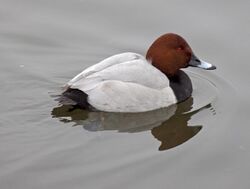Biology:Aythya
| Aythya | |
|---|---|

| |
| Common pochard (Aythya ferina) | |
| Scientific classification | |
| Domain: | Eukaryota |
| Kingdom: | Animalia |
| Phylum: | Chordata |
| Class: | Aves |
| Order: | Anseriformes |
| Family: | Anatidae |
| Tribe: | Aythyini |
| Genus: | Aythya F. Boie, 1822 |
| Type species | |
| Anas marila[1] Linnaeus, 1761
| |
| Species | |
|
12 species, see text | |
Aythya is a genus of diving ducks. It has twelve described species. The name Aythya comes from the Ancient Greek word αυθυια (authuia), which may have referred to a sea-dwelling duck or an auklet.[2]
Aythya shihuibas was described from the Late Miocene of China . Zelenkov (2016) transferred the species Anas denesi Kessler (2013), known from the late Miocene of Hungary, to the genus Aythya.[3] An undescribed prehistoric species is known only from Early Pleistocene fossil remains found at Dursunlu, Turkey;[4] it might however be referrable to a paleosubspecies of an extant species considering its age (see also Greater scaup).
The Miocene "Aythya" arvernensis is now placed in Mionetta, while "Aythya" chauvirae seems to contain the remains of two species, at least one of which does not seem to be a diving duck.[5]
The genus Aythya was introduced in 1822 by the German zoologist Friedrich Boie. The type species is the greater scaup.[6][7]
Aythya species
The genus contains 12 species.[8]
| Male | Female | Scientific name | Common name | Distribution | Conservation status |
|---|---|---|---|---|---|
 |
120px | A. valisineria | Canvasback | North America | least concern |
 |
120px | A. ferina | Common pochard | Northern Europe into Asia | vulnerable |
 |
120px | A. americana | Redhead | North America, from as far north as Northern Canada to the lower United States | least concern |
 |
120px | A. collaris | Ring-necked duck | Northern United States and Canada | least concern |
 |
120px | A. australis | Hardhead | Australia, New Guinea, New Zealand, and the islands of the Pacific | least concern |
 |
120px | A. baeri | Baer's pochard | Southeast Russia and northeast China, migrating in winter to southern China, Vietnam, Japan, and India | critically endangered |
 |
120px | A. nyroca | Ferruginous duck | From Iberia and the Maghreb east to western Mongolia, south to Arabia | near threatened |
 |
A. innotata | Madagascar pochard | Madagascar | critically endangered | |
 |
120px | A. novaeseelandiae | New Zealand scaup | New Zealand | least concern |
 |
120px | A. fuligula | Tufted duck | Throughout temperate and northern Eurasia; occasional visitor to the United States and Canada | least concern |
 |
120px | A. marila | Greater scaup | Alaska, northern Canada, Siberia, and the northernmost reaches of Europe | least concern |
 |
120px | A. affinis | Lesser scaup | Alaska through western Canada to western Montana, Central America | least concern |
Phylogeny
Based on the Taxonomy in Flux from John Boyd's website.[9]
| ||||||||||||||||||||||||||||||||||||||||||||||||||||||||||
See also
- Late Quaternary prehistoric birds
- List of fossil bird genera
Gallery
Canvasback (Aythya valisineria)
Common pochard (Aythya ferina)
Ring-necked duck (Aythya collaris)
Female Hardhead (Aythya australis)
Baer's pochard (Aythya baeri)
Ferruginous duck (Aythya nyroca)
Madagascar pochard (Aythya innotata)
New Zealand scaup (Aythya novaeseelandiae)
Tufted duck (Aythya fuligula)
Greater scaup (Aythya marila)
Lesser scaup (Aythya affinis)
References
| Wikimedia Commons has media related to Aythya. |
- ↑ "Anatidae". The Trust for Avian Systematics. https://www.aviansystematics.org/4th-edition-checklist?viewfamilies=14.
- ↑ Jobling, James A. (2010). The Helm Dictionary of Scientific Bird Names. London: Christopher Helm. p. 64. ISBN 978-1-4081-2501-4.
- ↑ Nikita V. Zelenkov (2016). "РЕВИЗИЯ НЕВОРОБЬИНЫХ ПТИЦ ПОЛГАРДИ (ВЕНГРИЯ, ВЕРХНИЙ МИОЦЕН). 1. Anseriformes". Paleontological Journal 50 (5). https://elibrary.ru/item.asp?id=26601037.
- ↑ Louchart, Antoine; Mourer-Chauviré, Cécile; Guleç, Erksin; Howell, Francis Clark & White, Tim D. (1998): L'avifaune de Dursunlu, Turquie, Pléistocène inférieur: climat, environnement et biogéographie. C. R. Acad. Sci. Paris IIA 327(5): 341–346. [French with English abridged version] doi:10.1016/S1251-8050(98)80053-0 (HTML abstract)
- ↑ Worthy, Trevor; Tennyson, A.J.D.; Jones, C.; McNamara, J.A. & Douglas, B.J. (2007): Miocene waterfowl and other birds from central Otago, New Zealand. J. Syst. Palaeontol. 5(1): 1–39. doi:10.1017/S1477201906001957 (HTML abstract)
- ↑ Boie, Friedrich (1822) (in de). Tagebuch gehalten auf einer Reise durch Norwegen im Jahre 1817. Schleswig. pp. 308, 351. https://archive.org/details/tagebuchgehalten00boie/page/308/mode/1up.
- ↑ Mayr, Ernst; Cottrell, G. William, eds (1979). Check-List of Birds of the World. 1 (2nd ed.). Cambridge, Massachusetts: Museum of Comparative Zoology. p. 482. https://www.biodiversitylibrary.org/page/16109122.
- ↑ Gill, Frank; Donsker, David; Rasmussen, Pamela, eds (January 2022). "Screamers, ducks, geese & swans". IOC World Bird List Version 12.1. International Ornithologists' Union. http://www.worldbirdnames.org/bow/waterfowl/.
- ↑ Taxonomy in Flux [1] Boyd, John (2007). "Aythyini". http://jboyd.net/Taxo/Aythyini.pdf.
Wikidata ☰ Q214300 entry
 |











